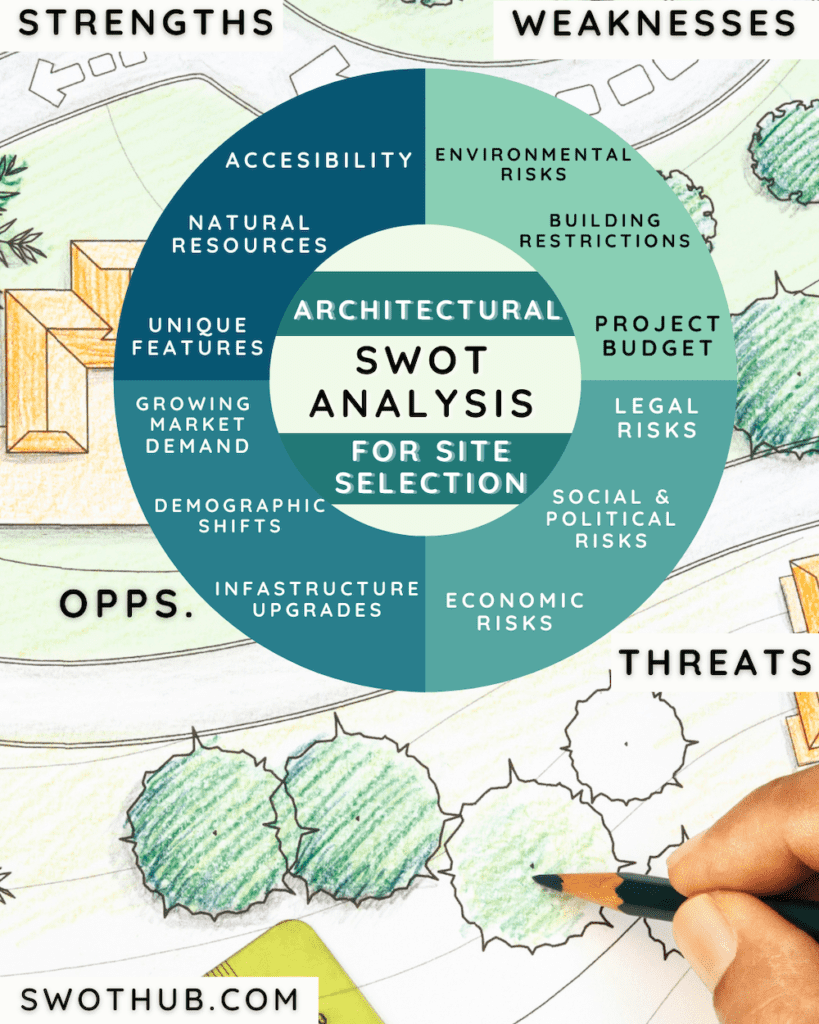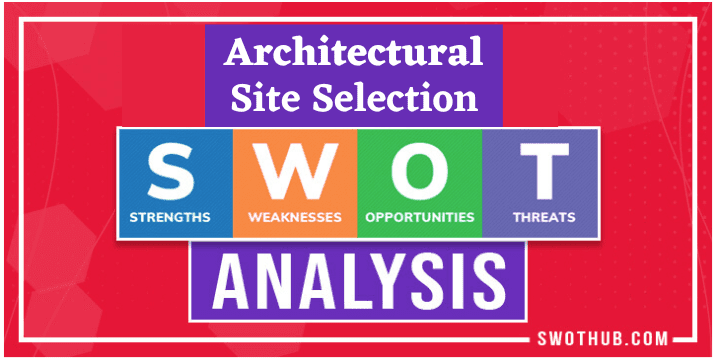If you’re an architect, architectural student, engineer, or design professional, understanding and conducting an architectural SWOT analysis can save you time, help solve design issues, and uncover potential challenges before you even start designing. Assessing the environment around the site, as well as identifying the strengths, weaknesses, opportunities, and threats, is a critical step. This architectural SWOT analysis guide highlights the actionable benefits of evaluating risks and rewards, helping you make well-informed decisions about where to build your project. For stakeholders or investors involved in the design and construction process, an architectural SWOT analysis for site selection is indispensable.
Table of Contents
The Importance of Site Selection
Key Benefits of Architectural SWOT Analysis for Site Selection
Conducting an architectural SWOT analysis is important for site selection because it helps evaluate the suitability of a location for a specific project based on the architectural aspects of the site. An architectural SWOT analysis can help identify the potential strengths and weaknesses of the site in terms of its design, construction, zoning regulations, and other factors that are essential for the successful completion of the project.
- Improved Decision-Making: Highlighting the site’s pros and cons enables stakeholders to make informed choices.
- Risk Mitigation: Identifying challenges and risks early helps minimize potential setbacks.
- Optimized Resource Allocation: Pinpointing opportunities ensures resources are used efficiently to maximize project outcomes.
- Enhanced Project Outcomes: Leveraging identified strengths and opportunities contributes to successful project completion.
Architectural SWOT Analysis:
A SWOT analysis is a framework used to assess an industry, company, or in this case an architectural site plan to create a strategic plan. By taking architectural strengths, and weaknesses, and threats of the site plan as well as opportunities of the architectural site plan into account, we may better gain in-depth knowledge about the best way to proceed with the design. In this article, we’ll be taking a look at an architectural SWOT framework to better understand its usefulness for all stakeholders, designers, and students alike.
Architectural SWOT Analysis Strengths:
Before diving into strengths, it’s important to understand how these positive site attributes can set the foundation for project success. Strengths refer to positive site attributes that can enhance project success. Examples include:
- Unique Features: Distinctive landmarks or architecture that create a competitive edge.
- Accessibility: Proximity to transportation networks, such as highways, airports, and public transit.
- Existing Infrastructure: Availability of utilities that reduce project costs and timelines.
- Favorable Zoning Regulations: Streamlined project approval due to supportive zoning laws.
- Natural Resources: Scenic views or water bodies that add value to the project.
- Historical Significance: Enhancing branding through the site’s architectural or cultural heritage.

Architectural SWOT Analysis Weaknesses:
In an architectural SWOT analysis for site selection, weaknesses refer to the negative attributes of a location that can hinder the success of a project. Some of the weaknesses that can be identified in an architectural SWOT analysis include:
- Inadequate infrastructure: Project costs and completion times may be affected by a lack of vital infrastructure, such as utilities, roads, or internet access.
- Environmental risks: The site may be at risk of natural disasters, such as flooding or earthquakes, or environmental hazards such as pollution, which can adversely affect the project.
- Building restrictions: Zoning regulations or building codes may prohibit or limit the project’s design or development potential.
- Competition: Other similar projects or businesses in the area can reduce the project’s market share or profitability.
- High costs: The site’s real estate prices or construction costs may be high, making the project financially unfeasible.
- Limited accessibility: The project’s success may be hampered by the site’s difficulty in being accessed by potential clients, suppliers, or workers.
- Identifying these weaknesses can help stakeholders to develop strategies to mitigate their impact and reduce potential risks associated with the project.
Architectural SWOT Analysis Opportunities:
Opportunities are the external factors that can favorably affect the project’s success in an architectural SWOT analysis for site selection. In a SWOT analysis of architecture, some of the opportunities that can be found include:
- Market Growth: Rising demand for the project’s services in the area.
- Economic Incentives: Tax breaks or subsidies reducing costs.
- Demographic Shifts: Favorable changes in population dynamics or preferences.
- Collaboration Potential: Proximity to institutions for partnerships.
- Technological Advancements: Innovations improving project outcomes.
- Infrastructure Upgrades: Planned developments enhancing accessibility and site value.
Architectural SWOT Analysis Threats:
The external factors that may have a negative impact on the project’s success are referred to as threats in an architectural SWOT analysis for site selection. An architectural SWOT analysis can be used to identify various threats, such as:
- Economic Risks: Market downturns or fluctuating interest rates reducing profitability.
- Legal Risks: Changes in regulations increasing costs or delays.
- Environmental Threats: Risks from natural disasters like floods or wildfires.
- Competitive Pressures: Intense local competition reducing market share.
- Political and Social Instability: Unstable conditions affecting project viability.
Architectural SWOT Analysis – Conclusion and Recommendations:
To ensure a thorough architectural SWOT analysis for site selection, the following recommendations can be given to the designer, stakeholders, and architectural design team:
- To perform a thorough architectural SWOT analysis for site selection, it’s essential to understand the value these recommendations bring to ensuring a well-informed and successful project plan. Follow these recommendations:
- Conduct a comprehensive site analysis incorporating all available data and stakeholder insights.
- Engage all stakeholders early in the process to ensure diverse perspectives.
- Align the project brief with defined goals and objectives.
- Leverage advanced tools such as GIS and BIM for accurate analysis.
- Emphasize sustainability and resilience in the project design.
- Integrate the design team early to align SWOT findings with architectural goals.
- By systematically evaluating the site’s strengths, weaknesses, opportunities, and threats, stakeholders can mitigate risks, optimize resources, and maximize the chances of project success.
FAQs for Architectural SWOT Analysis
What is the purpose of conducting an architectural SWOT analysis for site selection?
It serves the purpose of assessing the strengths, weaknesses, opportunities, and threats associated with a potential site. This analysis helps stakeholders, designers, and teams make informed decisions by understanding the site’s attributes, potential challenges, and advantages for the successful execution of a project.
How does an architectural SWOT analysis impact the decision-making process for site selection?
It provides a structured framework for evaluating a site’s suitability. By identifying strengths, weaknesses, opportunities, and threats, decision-makers gain insights into how well a site aligns with project goals.
What role do stakeholders play in an architectural SWOT analysis for site selection?
Stakeholders, including project owners, investors, community members, and designers, play a crucial role. Their perspectives and expertise contribute to a comprehensive assessment of the site. Engaging stakeholders ensures that diverse viewpoints are considered, potential challenges are addressed, and the final site selection decision takes into account the interests of all parties involved.
By following these recommendations, the designer, stakeholders, and architectural design team can perform a thorough site analysis and develop a strong foundation for the successful delivery of the project.





